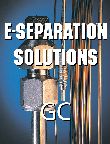Overcoming Compound Volatility with Sub-ambient ELSD
The success of evaporative light scattering detection relies on evaporating the eluent without destroying the analyte particle. Where the analyte is non-volatile, evaporator temperatures of 50-100 °C can be used without compound degradation, thus giving maximum sensitivity. However, when compounds have high vapor pressures and the eluent has a high boiling point (e.g. water), detection of semi-volatile compounds is problematic, because the evaporation temperature needs to be set at 30 °C or above in order to evaporate the solvent.

Revolutionizing LC-MS with Next-Gen Separation for Cyclic Peptide Analysis
February 17th 2025Cyclic peptides, known for their stability and high specificity, are promising therapeutic agents in the fight against cancer, infections, and autoimmune diseases. However, developing effective cyclic peptides presents numerous challenges, including poor pharmacokinetics, efficacy, and toxicity. Traditional methods like liquid chromatography tandem-mass spectrometry (LC-MS/MS) often struggle with resolving isomeric linear peptide metabolites, posing significant risks in safety, efficacy, and regulatory approval. In this paper, Komal Kedia, PhD, will share how she leveraged MOBIE’s high-resolution ion mobility-mass spectrometry (IM-MS) system to achieve a 72% reduction in run times, 200% greater resolving power, and enhanced accuracy in identifying “soft spots” prone to enzymatic degradation.

